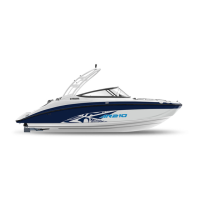4-74-6
SPARK PLUG CLEANING AND
ADJUSTMENT
The spark plug is an important engine
component and is easy to inspect. The
condition of the spark plug can indicate
something about the condition of the
engine. For example, if the center elec-
trode porcelain is very white, this could
indicate an intake air leak or carbure-
tion problem in that cylinder.
Do not attempt to diagnose any prob-
lems yourself. Instead, take the Sport
Boat to a Yamaha Sport Boat dealer.
You should periodically remove and
inspect the spark plug because heat
and deposits will cause the spark plug
to slowly break down and erode. If
electrode erosion becomes excessive,
or if carbon and other deposits are
excessive, you should replace the
spark plug with another of the correct
type.
Before installing the spark plug, mea-
sure the electrode gap with a wire
thickness gauge; adjust the gap to
specification if necessary.
When fitting the plug, always clean the
gasket surface and use a new gasket.
Wipe off any dirt from the threads and
screw in the spark plug to the correct
torque.
NOTE: Before installing the spark plug
cap, be sure to wipe off any water on
the spark plug or inside the cap. Push
the spark plug cap down until it clicks.
NOTE: If a torque-wrench is not avail-
able when you are fitting a spark plug,
a good estimate of the correct torque
(with a new gasket) is 1/4 to 1/2 turn
past finger-tight. Have the spark plug
adjusted to the correct torque as soon
as possible with a torque wrench.
When removing or installing a spark
plug, be careful not to damage the
insulator. A damaged insulator could
allow external sparks, which could
lead to explosion or fire.
Standard spark plug:
BR8HS
Spark plug gap: 0.6~0.7mm
(0.024~0.028 in)
Spark plug torque:
25 Nm (2.5 m-kg, 18 ft-lb)
PERIODIC INSPECTION CHART
Frequency of maintenance operations may be adjusted according to the operating conditions, but the
following table gives general guidelines.
● Indicates the checkups which you may do yourself.
■ Indicates work to be done by your Yamaha dealer.
Maintenance interval Initial Thereafter Page
Every
10 50 100 100 200
hours hours hours hours hours
36 612
months months months months
Spark plug
Inspection/Cleaning/
●●●●
4-7
Adjustment
Grease points Greasing
●●
4-8
Bearing housing Greasing
■
*1
●
*2
●
*2 4-9
Starter motor idle gear Greasing
■
*3
●
*4
●
*4 4-10
Fuel system Inspection
■■
4-11
Fuel filter Checking/Replacement
■■
4-12
Fuel tank Cleaning
■
4-12
Oil injection system Inspection/Cleaning
■■
4-12
Carburetor adjustment Inspection/Adjustment
■■■
4-13
Trolling speed (idle) Adjustment
●●
4-13
Carburetor throttle shaft Inspection
■■
●
(after
Cooling-water passages Cleaning/Flushing every 4-2
use)
Bilge strainer Cleaning
●● ●
Impeller Inspection
■■ ■
Steering cable Inspection
●
4-14
Throttle cable and choke cable Inspection/Adjustment
●●
4-14
Reverse gate mechanism Inspection
●●
4-15
Drain plugs Inspection/Replacement
●
●
(inspect
Battery Inspection fluid level 4-16
before every
launch)
Rubber coupling Inspection
■
Bolts and nuts Retightening
■■■
*1 Grease capacity: 33.0 ~ 35.0 cc (1.11 ~ 1.18 oz.)
*2 Grease capacity: 6.0 ~ 8.0 cc (0.20 ~ 0.27 oz.)
*3 Grease capacity: 8.0 cc (0.27 oz.)
*4 Grease capacity : 2.0 cc (0.07 oz.)
MAINTENANCE & CARE 4
4
MAINTENANCE & CARE

